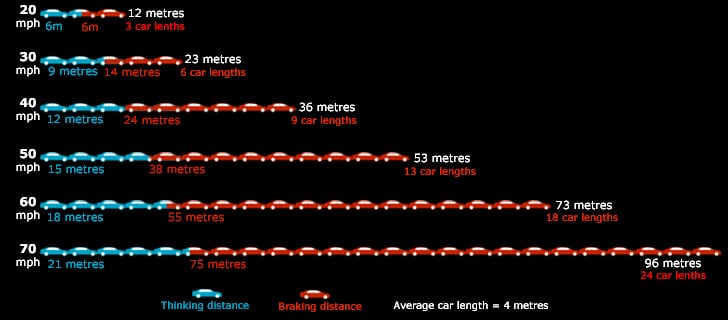Safety Margins Category
To learn all about the Safety Margins category watch the video or read the article below.
The theory test featuring all the questions from this category is at the bottom of the page.
Topics Include
- Road Surfaces – being aware of different road surfaces and how they can affect the driving experience.
- Skidding – how to prevent and deal with skidding whilst driving.
- Weather Conditions – being aware how different weather conditions can affect driving and road safety.
- Stopping Distances – knowing the distances required to stop a vehicle safely.
Again safety is the key theme. Add this to a fair dose of common sense and many of the questions answer themselves.
Weather conditions
- Braking distances on ice and in freezing conditions can be ten times the normal distance.
- Overall stopping distances will be much longer when driving in wet conditions.
- In windy conditions take extra care when passing cyclists and motorcyclists. Always allow them extra room.
- After driving through flood water the first thing you should do is test your brakes. You should then go slowly while gently applying the brakes, as this will help to dry them.
- In very hot weather the road surface can become soft. This can effect tyre grip and braking.
- Side winds are most dangerous on an open stretch of road.
- When driving on a motorway with surface spray use dipped headlights.
- When driving on snow or ice use the highest gear possible, as this helps avoid wheel spin. When approaching a sharp bend in such conditions you should slow down and avoid sudden steering movements.
- If your number plate, windows, lights or mirrors are covered in snow or ice you must clear them before staring a journey.
- You can tell you are driving on ice, and black ice, because your tyres make little noise and the steering becomes light.
- When driving in fog use dipped headlights, allow more time for your journey, slow down.
In wet conditions your car can aquaplane. This means the tyres have lifted off the surface of the road and are skating on the surface of the water. If your steering suddenly becomes very light, while driving on a wet road, this is a sign that your are aquaplaning. To correct it ease off the accelerator and allow the tyres to regain grip.
Other Facts to Know
- Don’t ‘coast’ – travel in neutral or with the clutch pedal pressed down as this will reduce the control you have over the car.
- When approaching a right-hand bend you should keep to the left as this will improve your view of the road ahead.
- When parking facing downhill turn the wheels towards the kerb and put the handbrake firmly on.
- Skidding is usually cause by driver error, driving too fast for the road conditions.
- To correct a skid you should drive into it, so if the back of your vehicle slides to the right you should steer to the right.
- To control the speed of your car when driving down hill, select a low gear, as this makes use of the engine brake, and use the brakes carefully.
Contraflows
A contraflow system is where one or more lanes have a direction of traffic against that of the rest of the carriageway. When you enter a contraflow you should:
- reduce your speed in good time
- choose a suitable lane in good time: signs will direct you
- keep a safe distance behind the vehicle in front.
Anti-Lock Brakes
- Prevent the wheels from locking which means the tyres are less likely to skid.
- Allow a vehicle to be steered whilst under braking.
- May not work as effectively when the road surface is loose or wet.
- In an emergency apply them rapidly and firmly.
- They will start to work just as the wheels are about to lock.
Stopping Distances
- Stopping distance + braking distance = stopping distance.
- In good, dry conditions leave a 2 second gap between you and the vehicle ahead.
- In wet weather, leave a 4 second gap.
- In icy weather, leave a 20 second gap.
The diagram shows overall stopping distances (thinking distance plus braking distance).

